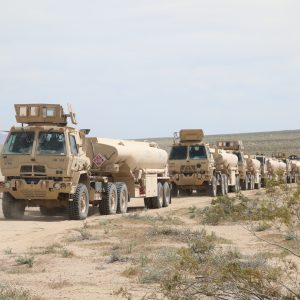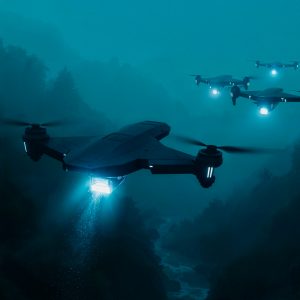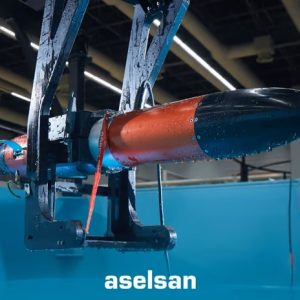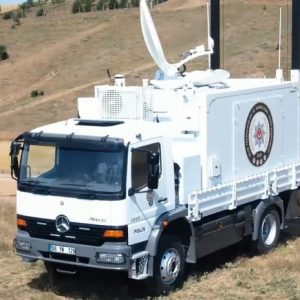Introduction
Turkish defense firm Roketsan has introduced a covert drone launcher that hides in plain sight, disguised as a standard shipping container on a truck. Unveiled at the IDEF 2025 defense expo in Istanbul, the containerized system is designed for surprise deep-strike attacks reminiscent of Ukraine’s daring Operation Spiderweb campaign. By blending in with civilian freight, this covert launcher can be moved close to conflict zones without drawing attention, then unleash a swarm of loitering munitions on high-value targets with little warning. The new platform highlights a shift toward stealthy, mobile firepower – delivering precision strikes from unexpected places.
Containerized Design for Hidden Deployment
Roketsan integrates the launcher into a standard freight container, which mounts directly onto a commercial truck trailer. From the outside, it appears to be ordinary cargo. Inside, however, it holds launch tubes for up to 12 drones. This configuration transforms a single vehicle into a covert drone launcher capable of deploying a dozen loitering munitions on demand. The containerized design gives crews both mobility and concealment. They can relocate frequently, park among civilian vehicles, and avoid detection. According to The Defense Post, the launchers disguise themselves as civilian cargo, enabling surprise attacks similar to Ukraine’s “Operation Spiderweb.” That Ukrainian campaign—a covert long-range drone strike deep inside Russian territory—proved the effectiveness of blending military assets into civilian infrastructure. Roketsan now applies the same tactic, providing the Turkish military with a stealthy tool for deep-strike missions.
Notably, Roketsan displayed the containerized launcher on a military truck at IDEF 2025, underscoring that it’s already beyond the concept stage. When deployed, the container’s panels open to allow the drones to launch. Once missions are complete, the truck can quickly pack up and move, avoiding counterfire. This kind of shoot-and-scoot capability dramatically improves survivability, as the launcher doesn’t have to remain in a fixed, vulnerable position after an attack. By using a commercial-looking platform, the system can also operate on regular roads and blend with logistics convoys, further enhancing its covert nature.
EREN Loitering Munition: Speed Over Endurance
At the heart of the new launcher is Roketsan’s EREN loitering munition, a next-generation drone-missile hybrid developed for rapid strikes. Weighing around 35 kg, EREN is a jet-powered kamikaze drone that prioritizes speed over endurance. It can reach targets over 100 km away in roughly 15 minutes, trading long loiter time for high-speed impact. This gives it a top speed in the hundreds of kilometers per hour – fast enough to streak past defenses in a short window. Unlike propeller-driven drones that might circle for an hour, EREN’s quick dash approach means minimal exposure to enemy air defenses before hitting the target.
Despite the short flight duration, EREN packs advanced guidance for precision. In the final attack phase, it switches to an optical terminal seeker – essentially a camera-based guidance system – to home in on the target. This electro-optical guidance ensures high accuracy, allowing EREN to strike within a few meters of aimpoint. It also enables engagement of moving or time-sensitive targets: an operator or onboard algorithm can adjust course in the last moments using the live video feed. The munition’s agility is notable; it’s designed to hit both ground targets (like command posts, radars, or vehicles) and low-altitude aerial targets such as helicopters or drones. By functioning as an intercept-or-strike dual-use weapon, EREN adds a layer of air defense capability in addition to offensive strike.
Roketsan emphasizes that EREN is multi-platform compatible. Originally developed to launch from various carriers, it can be deployed not only from the new truck launcher but also from helicopters, unmanned aerial vehicles (UAVs), naval vessels, or ground installations. This flexibility means the munition isn’t tied to a single delivery method – troops could, for example, air-drop a cluster of ERENs from a drone over enemy territory or fire them from a ship near the coastline. The new containerized truck option adds yet another launch mode, turning an everyday-looking truck stop or port into a potential drone strike launchpad. According to Roketsan, EREN’s relatively short flight time is a deliberate design choice to favor rapid deployment and high-impact strikes from these platforms. In essence, once an EREN is fired, it races to the target and relies on surprise and speed to prevent the enemy from reacting in time.
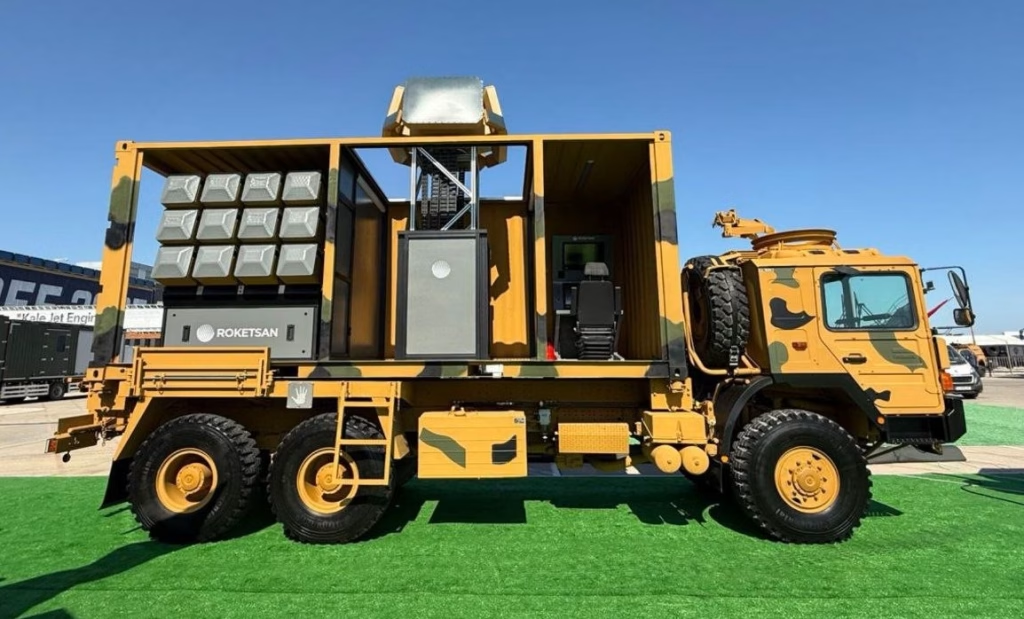
Roketsan’s covert drone launcher system is disguised as a freight container, seen here mounted on a truck at IDEF 2025. The container’s side is opened to reveal multiple launch tubes for the EREN loitering munitions (alt: Roketsan covert drone launcher).
Launch Configuration and Strike Capabilities
The launch configuration of Roketsan’s covert system consists of multiple sealed tubes or canisters housed within the container. The IDEF 2025 display showed rows of launch cells stacked inside, indicating each container unit can carry a salvo of 12 EREN munitions ready to launch. These drones can be fired in quick succession, allowing operators to saturate a target area or attack multiple sites almost simultaneously. In a combat scenario, a single disguised launcher could unleash a barrage of loitering munitions that arrive on target together, overwhelming air defenses or striking a spread of objectives at once. This swarm-like attack capability is a force multiplier – a handful of trucks could coordinate to send dozens of explosive drones into enemy airspace in a surprise volley.
Each EREN loitering munition carries an explosive warhead (exact size undisclosed) sufficient to destroy high-value targets like radar installations, ammunition depots, or parked aircraft. With a range exceeding 100 kilometers, the system enables deep strikes behind enemy lines without risking manned aircraft or requiring forward-deployed troops. Units can park near border areas or frontlines, launch attacks deep into hostile territory, and then relocate. The precision guidance of EREN further ensures that even distant targets can be hit reliably, provided they can be identified via the drone’s optical seeker or intelligence cues. This makes the covert drone launcher well-suited for taking out strategic targets (such as air defense batteries or command centers) in the opening phase of a conflict, or for high-impact special operations style missions.
The entire launcher system is remotely operable, meaning troops can control it from a safe distance or from a command vehicle. Operators would program target coordinates or control the drones in flight via secure datalink, all while the launcher remains unmanned during the strike for safety. This remote functionality, combined with the launcher’s mobility, means crews can “shoot-and-scoot” – fire off the drones and immediately drive away to avoid any return fire. By the time the enemy realizes an attack is underway, the actual launcher truck could be miles away. This tactic greatly complicates the enemy’s ability to retaliate or even identify what hit them.
It’s worth noting that this covert launcher is the first of its kind for Turkey’s armed forces, representing a new class of weapon in their arsenal. Military analysts see potential for Turkey to deploy these units at scale, using mass production of the relatively low-cost drones to equip multiple brigades or strategic points. There is also significant export potential: many countries are interested in loitering munitions and the idea of hidden launchers, especially after seeing their effectiveness in conflicts like Ukraine. Roketsan’s system, being containerized and modular, could be an attractive turnkey solution for militaries seeking an edge in long-range precision strike without investing in expensive aircraft or missiles. It aligns with a global trend where even major powers like the US and China are developing containerized missile launchers for flexibility.
Stealth, Guidance, and Survivability on the Battlefield
The defining feature of Roketsan’s new platform is its stealthy deployment. By concealing deadly drones in what looks like a harmless cargo container, the system achieves a level of tactical surprise that traditional missile launchers cannot. On a dynamic battlefield, this can dramatically improve survivability. Enemy reconnaissance satellites or scouts scanning for threats would see only a parked truck or a stack of containers – nothing immediately identifying it as a weapon. This allows the covert drone launcher to fire the first shot in a confrontation. From a strategic standpoint, the launcher’s ability to blend in with civilian logistics can delay or prevent enemy forces from targeting it. In the early phase of a conflict or during covert operations, that element of surprise is invaluable.
The EREN drones themselves contribute to stealth during flight. Their compact, jet-powered design likely has a small radar signature and a low-altitude flight profile, making detection difficult until the final moments. By the time an EREN shows up on radar or is heard overhead, it may be seconds from impact. Additionally, the use of optical guidance (instead of active radar guidance) in the terminal phase means the munition doesn’t emit telltale radar signals that could give it away. All these factors heighten the chance that the target will be struck out of the blue, with minimal warning.
However, the “hidden in plain sight” approach is not foolproof. Military analysts caution that the launcher, while covert, is only partially concealed – certain angles or closer inspection might reveal unusual features (such as hatches or firing ports) on the container. If an adversary becomes aware that such disguised launchers are in use, they could respond by tightening inspection protocols at checkpoints or by treating any unidentified trucks and containers near the front as potential threats. In Ukraine’s case, once Russian forces realized drones were being launched from inside their territory, they reportedly began scrutinizing and even attacking various logistical sites preemptively. Roketsan’s system would face a similar cat-and-mouse dynamic: its success hinges on the enemy not recognizing the threat until it’s too late. If the element of surprise is lost, the enemy may “widen their focus” and target surrounding civilian infrastructure or vehicles out of suspicion, which could escalate risks for non-combatants as well.
Despite those challenges, the covert launcher significantly enhances battlefield survivability for the operating side. Traditional artillery or missile batteries often have large signatures (heat, radar, or visual) and become prime targets after firing. In contrast, a containerized drone launcher can hide among countless similar containers in ports, rail yards, or truck convoys. This complicates the enemy’s targeting process – they would essentially be searching for a needle in a haystack. Even if one launcher is found and destroyed, others could remain undetected. As Ukraine’s Operation Spiderweb demonstrated, a well-planned surprise drone strike can throw a much larger opponent off balance, forcing them to reallocate resources to defense. Roketsan appears to be banking on this principle by providing Turkey with a tool for ambush-style aerial strikes that are hard to predict or counter.
Conclusion
Roketsan’s covert drone launcher system marks a significant leap in how militaries can deploy precision firepower. By combining mobility, concealment, and high-speed loitering munitions, it offers a novel way to conduct deep strikes while minimizing exposure to enemy retaliation. This development underscores a broader shift in modern warfare – one where stealth and deception can matter as much as range and firepower. Inspired by real-world lessons like Operation Spiderweb, Turkey’s new platform exemplifies the drive toward survivable, adaptive strike capabilities in an era of contested battlefields. As Ankara positions itself as a leader in drone warfare innovation, Roketsan’s containerized launcher could set a precedent for future systems that hide in plain sight and hit with precision when least expected.
Further Reading
- Turkey Goes ‘Operation Spiderweb’ With Hidden Drone Launcher for Surprise Strikes – The Defense Post, August 12, 2025.
- Inspired by Ukraine’s Operation Spiderweb? Turkey Unveils Hidden Drone Launcher for Deep Strikes – United24 Media, August 1, 2025.
- Roketsan Debuts Containerized EREN Loitering Munition Launcher at IDEF 2025 – Army Recognition, July 31, 2025.
- Covert Drone Strike Inside Russia (Operation “Spiderweb”) – Defense Express (Ukraine), July 2025 (analysis of Ukraine’s Spiderweb operation).



